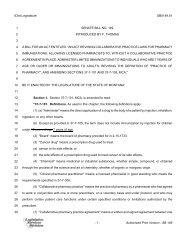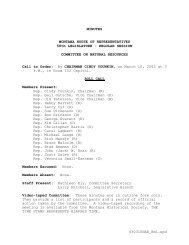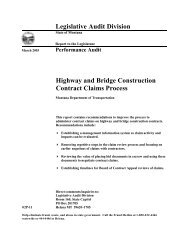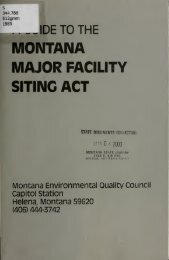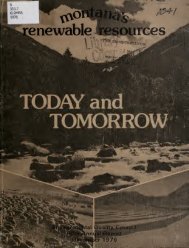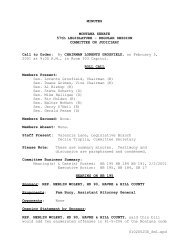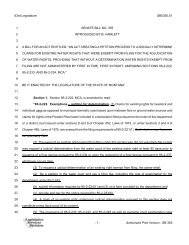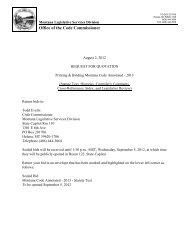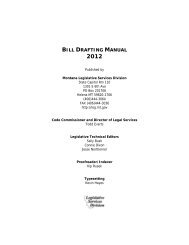Public Comment. Volume III - Montana Legislature
Public Comment. Volume III - Montana Legislature
Public Comment. Volume III - Montana Legislature
You also want an ePaper? Increase the reach of your titles
YUMPU automatically turns print PDFs into web optimized ePapers that Google loves.
EQC Eminent Domain<br />
Subcommittee-<strong>Public</strong> Hearing<br />
March 23,2000<br />
Exhibit 13<br />
Eminent Domain Ref01-111s<br />
For Private Property Protection<br />
Summary of Reform Package Proposed by NRPC<br />
Before the Environmental Quality Council<br />
Billings 3123100-<br />
For many decades, <strong>Montana</strong> landowners have been exploited and their land, water and<br />
other property unnecessarily damaged under the state's antiquated, 123-year-old eminent domain<br />
law. Working with NPRC, landowners from across the state have developed the following<br />
platform of eminent domain reforms to ensure fair treatment for landowners whose property is<br />
- crossed by public or private industrial rights-of-way. Where noted, proposals similar to these<br />
have already been enacted into law in other states. ALSO, where noted, some of the following<br />
reforms were proposed in legislation introduced during the iggg <strong>Legislature</strong>.<br />
Minimizing damage to private property:<br />
Central to the eminent domain law is the principle that a project must do minimum damage to<br />
private property while providing maximum public benefit. However, in reality, under the threat of<br />
condemnation landowners find they have little or no say in picking the least damaging route for a<br />
right-of-way across their land. Landowners then find they must aggressively watchdog the project<br />
to ensure proper construction and reclamation. Even then, reclamation is often highly inadequate,<br />
resulting in weed infestations and many other problems.<br />
In contrast to rights-of-way across private lands, developers are held to much higher<br />
standards and must comply with much stronger land and water protection requirements on the<br />
public lands they cross.<br />
To ensure full and equal protection of land, water and other property, private property should<br />
be given the same level of protection required on public lands. For every project, the law should<br />
require that a mitigation plan is developed through a process that includes public comment. The<br />
state should monitor each plan and publish annual monitoring reports. Most important, if the state<br />
fails to enforce a mitigation plan, citizens must have the right to go to court to require enforcement.<br />
As required for pipelines developers under Colorado law, any private industry developing a<br />
right-of-way in <strong>Montana</strong> must post a reclamation bond.<br />
Determining true public use:<br />
The law should not presume that every pipeline, railroad, powerline or mine serves a<br />
public purpose that justifies the taking of private property. When a developer wants to take<br />
private property under the eminent domain law, they should have to show clear and convincing<br />
evidence that they are taking it for a truly public use. <strong>Public</strong> use should be determined on a<br />
case-by-case basis under criteria established in law.<br />
If the project is not a legitimate public use, then the developer should not be given the<br />
power to threaten condemnation when negotiating with landowners. They should be required to<br />
negotiate with landowners on a level playing field.<br />
Specifically, hard rock mines should not get special treatment under the law. Currently,<br />
<strong>Montana</strong> law does not grant the power of eminent domain to any other kind of mine.<br />
EQC Eminent Domain Study -1 69-



